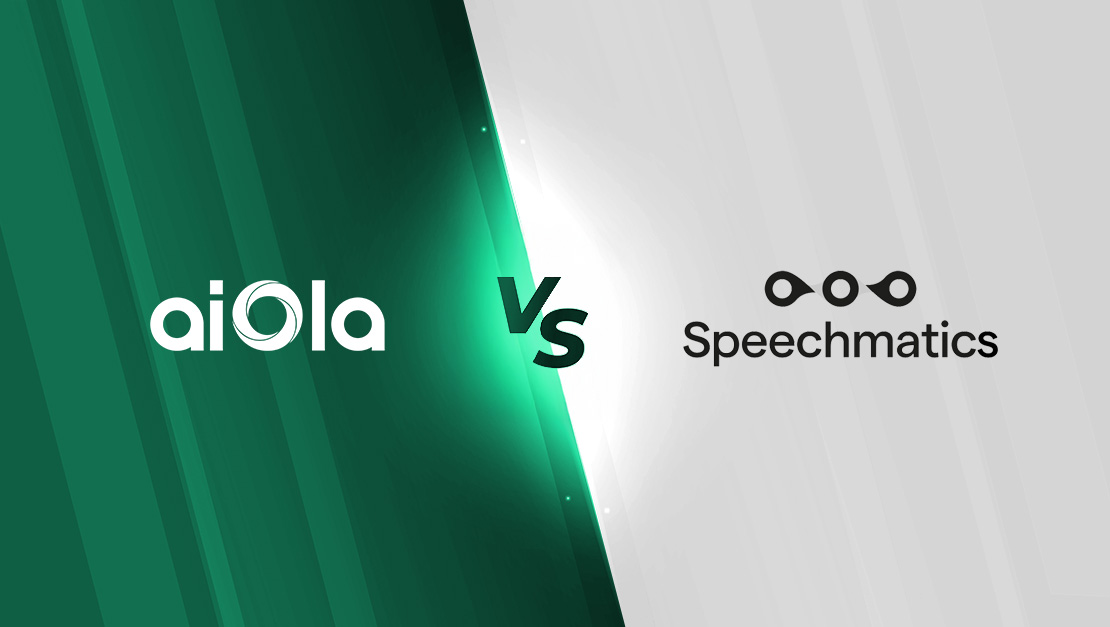When you’re choosing the right voice AI platform for your business, whether it be aiOla vs Speechmatics, it’s not just about speed and accuracy. It’s about how well the tool fits into your workflows, handles industry-specific language, and performs under pressure.
In this article, we’ll compare aiOla vs Speechmatics, focusing on what really matters for enterprise teams: accuracy in noisy environments, integration capabilities, jargon recognition, and security.
What Do aiOla vs Speechmatics Do?
Let’s take a look at aiOla vs Speechmatics, with an explanation of what each one does.
aiOla is purpose-built for enterprise environments where speed, precision, and structure are critical. Think high-pressure settings like aviation, logistics, manufacturing, and field services—places where team members don’t have time to stop and type. aiOla allows them to use their voice to instantly log data, document safety events, and trigger workflow actions. Unlike traditional speech-to-text tools, aiOla doesn’t just transcribe—it understands, organizes, and secures the data it hears, delivering structured, compliance-ready outputs in real time.
Speechmatics, on the other hand, is known for its advanced transcription engine with strong multilingual support and a user-friendly API. It’s commonly used in customer service, podcast transcription, media captioning, and accessibility applications. Speechmatics focuses on general-purpose speech recognition, delivering accurate transcripts for a wide range of languages and accents—particularly in clean audio conditions.
While both platforms offer speech AI, they serve different needs. aiOla is designed for operational intelligence in the field; Speechmatics is ideal for static, post-event transcription tasks in controlled environments.
Comparison of Key Features: aiOla vs Speechmatics
Let’s take a deep dive into how aiOla vs Speechmatics measure up:
Use Cases: Everyday Transcription vs. Operational Voice Logging
Speechmatics shines in consumer-friendly and post-processing use cases like podcasts, meeting transcriptions, and customer support recordings. It performs best in environments where audio quality is consistent and speakers follow a predictable, conversational flow. For teams looking to transcribe large volumes of clear audio for reference, documentation, or accessibility, Speechmatics offers a fast and flexible solution.
aiOla, however, is purpose-built for the opposite—complex, high-pressure operational environments. It excels in real-time voice logging for safety inspections, compliance reporting, field service updates, and any situation where frontline teams are on the move.
Whether you’re in a warehouse, an aircraft hangar, a moving vehicle, or a construction site, aiOla enables hands-free, on-the-go documentation. It’s not just about turning speech into text—it’s about generating structured, actionable data that integrates directly into enterprise systems. This makes it ideal for industries where accuracy, speed, and accountability aren’t optional—they’re mission-critical.
AMI Meeting Performance: aiOla Stands Out in Complexity
The AMI Meeting dataset is a well-known benchmark for real-world transcription. It simulates overlapping conversations, background noise, and multiple speakers.
aiOla consistently outperforms on this benchmark, thanks to its ability to parse chaotic, unscripted dialogue. It understands who is speaking, separates voices accurately, and doesn’t lose track when people talk over each other.
Speechmatics performs well on cleaner datasets but hasn’t shown the same consistency on AMI-level complexity.
ASR Performance and Word Error Rate (WER)
On standardized benchmarks like LibriSpeech and CommonVoice, both aiOla and Speechmatics perform competitively. But enterprise value isn’t about how models do in a lab—it’s how they handle real-world, messy audio.
aiOla is trained for noisy, fast, unpredictable speech. It’s used in environments where accents vary, jargon flies, and clarity is critical. According to internal tests, aiOla achieves up to 95% precision on technical terms without needing to be trained on them.
Speechmatics delivers strong WERs for clean speech and multilingual text, but may struggle with jargon or audio distortion unless customized or prompted.
Enterprise-Grade Jargon Recognition
This is where aiOla truly shines. Its Jargonic ASR technology is designed to instantly understand specialized language—whether it’s aviation acronyms, complex medical terminology, legal compliance phrases, or industry-specific jargon—right out of the box. There’s no waiting for extensive training or data labeling. Thanks to zero-shot learning, aiOla can accurately interpret new and evolving terminology immediately, adapting effortlessly to your unique vocabulary without manual input.
In contrast, Speechmatics provides customization options but typically requires users to create detailed prompts, fine-tune parameters, or upload numerous domain-specific examples to achieve comparable accuracy. This can slow down deployment and increase overhead, especially in fast-moving industries where new jargon emerges regularly.
aiOla’s approach not only accelerates implementation but also reduces the burden on your team, making it a highly efficient and scalable solution for enterprises needing reliable jargon recognition from day one.
Performance in Noisy, Multi-Speaker Environments
Let’s be honest: most AI speech recognition tools perform well in controlled, quiet rooms—but frontline teams rarely operate in such ideal conditions. Real-world environments are often loud and chaotic, filled with background noise like machinery hum, overlapping conversations, and unpredictable speech patterns.
aiOla is specifically trained to excel under these challenging conditions. It can effectively filter out irrelevant noise, distinguish multiple speakers even when they talk simultaneously, isolate critical keywords, and provide accurate, structured output.
This robustness ensures that teams working in manufacturing plants, construction sites, aviation, or emergency response can rely on aiOla to capture precise data without interruptions or errors.
While Speechmatics does offer speaker diarization features, it has yet to demonstrate the same consistent resilience and accuracy in rugged or highly dynamic environments. aiOla’s superior noise-handling capabilities make it the ideal choice for enterprises needing dependable transcription in the toughest real-world settings.
Languages and Accents
Speechmatics supports multiple languages and accents, making it a good pick for global teams. It boasts coverage of over 30+ languages with accent detection.
aiOla, by contrast, supports over 120 languages and dialects, including regional nuances. More importantly, it adapts to accents and noisy pronunciation without losing accuracy—which is critical in industries like aviation, manufacturing, or logistics where native fluency varies.
Speech-to-Text API and Integration
Both platforms offer developer APIs, but their focus differs.
Speechmatics provides fast, flexible APIs ideal for transcription apps, consumer services, or lightweight integrations.
aiOla takes it further with structured voice inputs, real-time reporting, and deeper integrations with enterprise systems like ERPs, CRMs, and compliance software. It also offers robust audit trails and access controls, making it easier for regulated teams to deploy.
Data Privacy and Compliance
If you’re in a regulated industry, this one’s a dealbreaker.
aiOla offers enterprise-grade compliance with:
- End-to-end encryption
- Role-based access
- Secure, auditable logs
- Deployment flexibility (cloud, hybrid, or on-prem)
Speechmatics takes security seriously but is geared more toward general-purpose use. Its offerings around compliance and auditability may require additional configuration for highly regulated industries.
Summary: aiOla vs Speechmatics—Which Should You Choose?
Both aiOla vs Speechmatics are solid voice AI tools—but they’re built for different missions.
If you’re looking for a general-purpose transcription engine for multilingual text, Speechmatics is fast, flexible, and developer-friendly. But if you need voice AI that can handle industry jargon, chaotic environments, frontline documentation, and enterprise-grade compliance—aiOla is built for you. It doesn’t just transcribe. It listens. It structures. And it integrates directly into your business without changing how your team works.
Want to see how aiOla can improve your team’s voice workflows? Book a personalized demo and see what enterprise-ready speech AI can really do.













